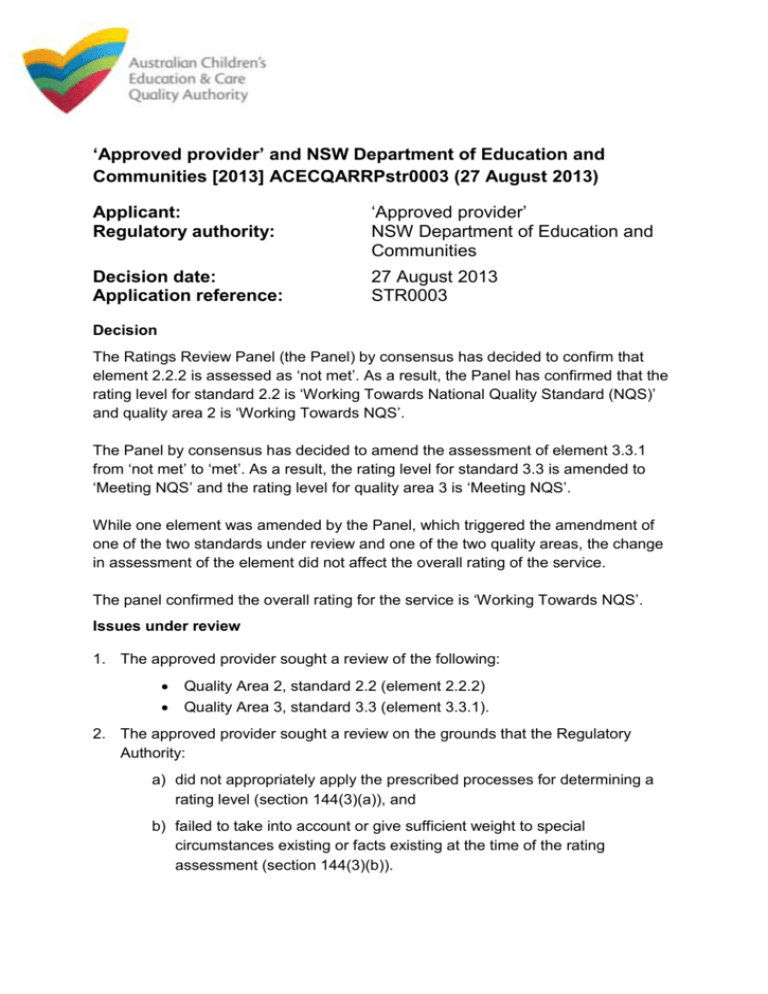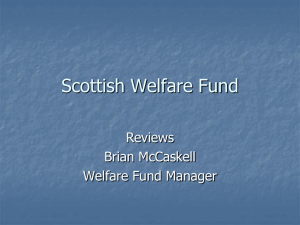Approved provider
advertisement

‘Approved provider’ and NSW Department of Education and Communities [2013] ACECQARRPstr0003 (27 August 2013) Applicant: Regulatory authority: ‘Approved provider’ NSW Department of Education and Communities Decision date: Application reference: 27 August 2013 STR0003 Decision The Ratings Review Panel (the Panel) by consensus has decided to confirm that element 2.2.2 is assessed as ‘not met’. As a result, the Panel has confirmed that the rating level for standard 2.2 is ‘Working Towards National Quality Standard (NQS)’ and quality area 2 is ‘Working Towards NQS’. The Panel by consensus has decided to amend the assessment of element 3.3.1 from ‘not met’ to ‘met’. As a result, the rating level for standard 3.3 is amended to ‘Meeting NQS’ and the rating level for quality area 3 is ‘Meeting NQS’. While one element was amended by the Panel, which triggered the amendment of one of the two standards under review and one of the two quality areas, the change in assessment of the element did not affect the overall rating of the service. The panel confirmed the overall rating for the service is ‘Working Towards NQS’. Issues under review 1. The approved provider sought a review of the following: Quality Area 2, standard 2.2 (element 2.2.2) Quality Area 3, standard 3.3 (element 3.3.1). 2. The approved provider sought a review on the grounds that the Regulatory Authority: a) did not appropriately apply the prescribed processes for determining a rating level (section 144(3)(a)), and b) failed to take into account or give sufficient weight to special circumstances existing or facts existing at the time of the rating assessment (section 144(3)(b)). 3. After the initial assessment, the service was rated as ‘Working Towards NQS’ for standards 2.1, 2.2, 3.3, 5.2 and 6.3. The approved provider applied for first tier review on the basis that the Regulatory Authority did not consider evidence, available on the day, in its assessment and that the authorised officer’s personal opinions were given more weight than facts in determining the ratings. Further, the approved provider asserted that the first tier review was not completed within the legislated 30 day timeframe, meaning the prescribed processes for completing a first tier review were not applied. First tier review 4. At first tier review, the Regulatory Authority amended the rating levels for standards 2.1, 5.2 and 6.3. The rating levels for standards 2.2 and 3.3 remained unchanged at ‘Working towards NQS’. Applicant’s view 5. The approved provider claimed in its application for second tier review that the assessing authorised officer (the officer) did not consider all evidence available on the day of the assessment and rating visit. Specifically, that the officer did not review relevant documents or ask questions of educators to gather enough evidence to be able to determine an accurate rating. The approved provider also claimed that the officer’s personal opinions were given more weight than facts in determining the ratings. 6. The approved provider claimed that the outcome of the first tier review was negatively influenced by the fact that the only evidence considered was evidence recorded by the officer at the time of the visit. 7. Further, the approved provider asserted that the first tier review was not completed within the legislated 30 day timeframe, and that the Regulatory Authority did not request further information or seek to extend the timeframe. Evidence before the panel 8. The Panel considered all the evidence provided by the applicant and the Regulatory Authority. This included: o the application for second tier review and its attachments, including the service’s feedback on the draft assessment and rating report o the assessment and rating instrument and final assessment and rating report o the NSW Regulatory Authority’s findings on first tier review o the response from the approved provider to the Regulatory Authority’s information o additional evidence from the provider in the form of photographs and copies of service policies, minutes and program documentation o findings from Ratings Review Panel 2/2013 (STR0002). 2 9. The panel was also provided with advice from ACECQA on the elements, standards and quality areas under review. The law 10. Section 151 states ‘Following a review, the Ratings Review Panel may: (a) (b) confirm the rating levels determined by the regulatory authority; or amend the rating levels’. 11. Information on the application of the National Quality Standard is available in the Guide to the National Law and Regulations and the Guide to the National Quality Standard published on ACECQA’s website. The facts 12. The assessment and rating visit took place on 20 February 2013. 13. The approved provider received the assessment and rating decision on 16 April 2013. 14. The approved provider applied for first tier review on 30 April 2013. The NSW Regulatory Authority made a decision on the review on 21 June 2013. The provider received the decision on 24 June 2013. 15. The service is a centre-based Preschool/Kindergarten. Review of rating levels 16. The Panel considered each standard and elements under review in turn. Standard 2.2 17. Standard 2.2 is that: ‘Healthy eating and physical activity are embedded in the program for children’. 18. This standard is made up of two elements, one of which was under review. Element 2.2.2 19. Element 2.2.2 requires: ‘Physical activity is promoted through planned and spontaneous experiences and is appropriate for each child’. 20. In its application for second tier review, the approved provider wrote that the authorised officer only gathered evidence of some activities that were provided to children on the day of the assessment and rating visit and failed to note the significance of the way the environment was set up. 3 21. The provider also wrote that the officer failed to seek additional evidence that would have informed the rating decision by not questioning educators or viewing available documentation. 22. The Panel agreed that the service has a large outdoor area set up for an all-day indoor/outdoor program, where children are able to engage in physical activity appropriate to their abilities and preferences. 23. The Panel noted that the evidence used to rate element 2.2.2 as ‘not met’, differs between the assessment and rating report and the first tier review decision notice. Specifically, that the original decision seemed to rely on the statement that music group sessions are conducted in limited space for movement, while the first tier review decision document cites limited evidence of planned physical activity as the basis for the rating. 24. The Panel discussed the meaning of ‘planning’ in this element and agreed that evidence of planning could be gathered through conversations with educators as well as reviewing program documentation. The Panel agreed that it is not reasonable to expect educators to document every planning decision they make during the day. 25. The Panel discussed that the activities the service had provided for children would not happen without planning. The Panel agreed that planning that is documented is preferable, but it is not the only way for planning to be evident. 26. The Panel noted the additional evidence provided by the provider at second tier review and agreed that these examples of programming documentation are evidence of some planning for children’s physical activity. 27. The Panel noted photographs included by the provider, taken in August 2013, as examples of activities that would have been carried out on the day of the assessment and rating visit and to show the typical set up of the indoor and outdoor environments. However, the Panel acknowledged that they could only take into account new information during a second tier review if it was related to the facts that existed at the time of the assessment and rating decision. 28. The Panel concluded that while there is sound evidence that physical activity is promoted with children generally, through planned and spontaneous experiences, and that there is evidence of planning for physical activity, there is insufficient evidence to be able to conclude that the planning is appropriate for each child. For this reason, the Panel confirmed that the element is assessed as ‘not met’. Standard 3.3 29. Standard 3.3 is that: ‘The service takes an active role in caring for its environment and contributes to a sustainable future’. 30. It is made up of two separate elements, one of which was under review. 4 Element 3.3.1 31. Element 3.3.1 requires: ‘Sustainable practices are embedded in service operations’. 32. The Panel considered the findings of the Ratings Review Panel decision STR0002, relating to the notion of what constitutes ‘embedded practice’. The Panel discussed the meaning of the term ‘embedded’, concluding that it does set a high benchmark. 33. The Panel discussed the service’s environmental sustainability policy and agreed that it appears to reflect some of the practices of the service. 34. The Panel noted the information in the initial decision and at first tier review, and agreed that these show positive examples of sustainable practice. For example, use of recycled/junk materials in craft experiences, children using the recycling bin, water tank near the sand pit, food scrap recycling and vegetable garden. 35. The Panel also noted the comments of the Regulatory Authority at first tier review, and questioned the weight applied to what is described as a lack of evidence of a commitment to environmental sustainability embedded in the service operations – specifically, in the service philosophy, policies and procedure documents. 36. The Panel considered the samples of programming documentation and copies of staff meeting and committee meeting minutes provided at second tier review, agreeing that these supported the service’s claims that sustainable practices are embedded in their operations. The Panel did however note opportunities for the service’s environmental sustainability policy document to be tailored and localised. 37. The Panel considered the service’s outdoor environment and its range of natural features in its consideration of this element, including the grass, natural soft fall material, trees and garden areas, and discussed how the service’s investment in maintaining natural elements is evidence of a service which cares actively for its environment. 38. The Panel concluded that this element should be amended to ‘met’. The Panel noted that by amending this element, the service met all elements under standard 3.3. The Panel briefly considered whether there was evidence to support a rating of ‘Exceeding National Quality Standard’ for the standard and concluded that the evidence supported a rating of ‘Meeting National Quality Standard’ for standard 3.3. 5







